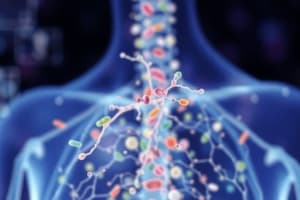Podcast
Questions and Answers
Which of the following best describes the term 'holobionts'?
Which of the following best describes the term 'holobionts'?
- The microorganisms existing in or on an organism.
- Hosts and microbes living and evolving together as a unit. (correct)
- The collective microbial genes found in a specific environment.
- Microbial organisms adapting to extreme environments.
Which factor does NOT significantly influence the composition of a microbial niche?
Which factor does NOT significantly influence the composition of a microbial niche?
- Diet
- Hair color (correct)
- Sex
- Body location
A newborn's initial exposure to microbes is MOST influenced by what factor?
A newborn's initial exposure to microbes is MOST influenced by what factor?
- The type of formula the baby is fed.
- The climate in which the baby is born.
- Whether the delivery is vaginal or via cesarean section. (correct)
- The baby's exposure to siblings.
Which of the following describes the role of bifidobacteria in infant gut health?
Which of the following describes the role of bifidobacteria in infant gut health?
The MOST accurate description of the adult human microbiota is:
The MOST accurate description of the adult human microbiota is:
Which of the following is NOT considered one of the six major phyla of bacteria common to human skin and mucosal surfaces?
Which of the following is NOT considered one of the six major phyla of bacteria common to human skin and mucosal surfaces?
The skin's slightly acidic pH and high NaCl concentration contribute to which of the following?
The skin's slightly acidic pH and high NaCl concentration contribute to which of the following?
What is the primary role of Staphylococcus epidermidis on healthy skin?
What is the primary role of Staphylococcus epidermidis on healthy skin?
The MOST diverse microbial population is typically found in which area of the respiratory tract?
The MOST diverse microbial population is typically found in which area of the respiratory tract?
How do microbes primarily colonize the lower respiratory tract?
How do microbes primarily colonize the lower respiratory tract?
Which of the following characteristics is MOST important for microbes colonizing the mouth?
Which of the following characteristics is MOST important for microbes colonizing the mouth?
What is the primary factor that determines which microorganisms can survive in the stomach?
What is the primary factor that determines which microorganisms can survive in the stomach?
Which section of the small intestine has the FEWEST microorganisms and why?
Which section of the small intestine has the FEWEST microorganisms and why?
What characteristic differentiates the gut microbiome of people in industrialized nations from those who consume plant-based diets?
What characteristic differentiates the gut microbiome of people in industrialized nations from those who consume plant-based diets?
Which best describes the typical microbial environment of the kidneys, ureter, and urinary bladder?
Which best describes the typical microbial environment of the kidneys, ureter, and urinary bladder?
Before antibiotics, what is the mechanism that inhibits pathogens from colonizing a particular body site?
Before antibiotics, what is the mechanism that inhibits pathogens from colonizing a particular body site?
What BEST explains why germ-free (GF) mice are valuable in microbiome research?
What BEST explains why germ-free (GF) mice are valuable in microbiome research?
How does the gut microbiome influence the central nervous system (CNS)?
How does the gut microbiome influence the central nervous system (CNS)?
What is a key characteristic of metabolic endotoxemia?
What is a key characteristic of metabolic endotoxemia?
How does a diet high in red meat contribute to cardiovascular disease according to current understanding of the gut microbiome?
How does a diet high in red meat contribute to cardiovascular disease according to current understanding of the gut microbiome?
What is the role of gut microbes in people who are considered overweight?
What is the role of gut microbes in people who are considered overweight?
Which of the following BEST describes the association between microbes and cancer?
Which of the following BEST describes the association between microbes and cancer?
Which of the following BEST describes a pre-biotic?
Which of the following BEST describes a pre-biotic?
Why is it difficult to ensure the uniformity and effectiveness of microbes as therapeutic agents?
Why is it difficult to ensure the uniformity and effectiveness of microbes as therapeutic agents?
The absence of microbes in the gut has been linked to which health concern?
The absence of microbes in the gut has been linked to which health concern?
Which of the following is correlated to elevated rates of cancer in individuals?
Which of the following is correlated to elevated rates of cancer in individuals?
Why are are microbiota found in external auditory canals?
Why are are microbiota found in external auditory canals?
What is the predominant bacterium found on the conjunctiva of the eye?
What is the predominant bacterium found on the conjunctiva of the eye?
What happens if you do a fecal transplant from an obese mouse into a regular mouse?
What happens if you do a fecal transplant from an obese mouse into a regular mouse?
In a vaginal environment high in glycogen, what action occurs?
In a vaginal environment high in glycogen, what action occurs?
What type of cell is needed to absorb anti-microbial IgA?
What type of cell is needed to absorb anti-microbial IgA?
Which genus does Gardnerella belong to?
Which genus does Gardnerella belong to?
After menopause, what typically is the dominant occurrence regarding vaginal microbial states?
After menopause, what typically is the dominant occurrence regarding vaginal microbial states?
Which phylum is represented primarily by the methane producers?
Which phylum is represented primarily by the methane producers?
In addition to bacteria and archaea, which other types of microbes are present?
In addition to bacteria and archaea, which other types of microbes are present?
Where does microbial life flourish in the gut?
Where does microbial life flourish in the gut?
Under normal conditions, which route enables microbiota to signal enteric nervous system?
Under normal conditions, which route enables microbiota to signal enteric nervous system?
Bacteriocins, Type VI secretion, peptidoglycan, SCFAs, and antimicrobial peptides represent which mechanism?
Bacteriocins, Type VI secretion, peptidoglycan, SCFAs, and antimicrobial peptides represent which mechanism?
Staphylococcus epidermidis creates what that activates keratinocytes interaction in the skin?
Staphylococcus epidermidis creates what that activates keratinocytes interaction in the skin?
Which bacterial influence is heritable?
Which bacterial influence is heritable?
Flashcards
Microbiome
Microbiome
All the genes found in one's microbiota.
Microbiota
Microbiota
All the microorganisms that live in and on an organism.
Holobionts
Holobionts
Hosts and microbes live together and evolve together.
Microbiota Development
Microbiota Development
Signup and view all the flashcards
Vaginal Birth
Vaginal Birth
Signup and view all the flashcards
Cesarean Delivery
Cesarean Delivery
Signup and view all the flashcards
Bifidobacteria
Bifidobacteria
Signup and view all the flashcards
Adult Human Microbiota
Adult Human Microbiota
Signup and view all the flashcards
Internal Tissue Microbiota
Internal Tissue Microbiota
Signup and view all the flashcards
Surface Tissue Microbiota
Surface Tissue Microbiota
Signup and view all the flashcards
Staphylococcus epidermidis
Staphylococcus epidermidis
Signup and view all the flashcards
Upper Respiratory Tract
Upper Respiratory Tract
Signup and view all the flashcards
Lower Respiratory Tract
Lower Respiratory Tract
Signup and view all the flashcards
Mouth Anaerobes
Mouth Anaerobes
Signup and view all the flashcards
Oral Bacteria
Oral Bacteria
Signup and view all the flashcards
Stomach Microbiota
Stomach Microbiota
Signup and view all the flashcards
Gut Microbiome Roles
Gut Microbiome Roles
Signup and view all the flashcards
Urinary Tract Microbiota
Urinary Tract Microbiota
Signup and view all the flashcards
Female Genital Tract
Female Genital Tract
Signup and view all the flashcards
Functional Core Microbiome
Functional Core Microbiome
Signup and view all the flashcards
Metabolic Role
Metabolic Role
Signup and view all the flashcards
Colonization Resistance
Colonization Resistance
Signup and view all the flashcards
Antibiotic Impact
Antibiotic Impact
Signup and view all the flashcards
Antibiotic Risks
Antibiotic Risks
Signup and view all the flashcards
Toxic Peptides
Toxic Peptides
Signup and view all the flashcards
Behavioral Traits
Behavioral Traits
Signup and view all the flashcards
Microbiome Influence
Microbiome Influence
Signup and view all the flashcards
Metabolic Syndrome
Metabolic Syndrome
Signup and view all the flashcards
Probiotics
Probiotics
Signup and view all the flashcards
Prebiotic
Prebiotic
Signup and view all the flashcards
Synbiotics
Synbiotics
Signup and view all the flashcards
Skin top predominant bacterial
Skin top predominant bacterial
Signup and view all the flashcards
Fecal microbiota transplantation (FMT)
Fecal microbiota transplantation (FMT)
Signup and view all the flashcards
Study Notes
- Human Microbiome refers to the collective genetic material of microorganisms in a particular environment.
- Microbiota consists of all microorganisms living in/on an organism.
- Holobionts describes hosts and microbes evolving and living together.
- Microbial niches are impacted by body location, age, sex, diet, and environment.
Microbiome Development
- The microbiota community is dynamic, changing with age and development.
- Microbiome development begins at birth and stabilizes by age 3.
- A diverse microbiome is essential for health.
Early Colonization
- Newborn colonization is important for establishing a healthy microbiome.
- Vaginal birth exposes newborns to beneficial microbes from the mother.
- Cesarean delivery exposes newborns to microbes from the initial caretakers.
- Bifidobacteria transport polymeric sugars from breast milk across their plasma membrane.
- Fermentation of these sugars provides calories and lowers gut pH, inhibiting pathogen growth.
Adult Microbiota
- Adult human microbiota is generally stable but can change due to physical or lifestyle factors.
- Microbiota varies among individuals and body sites.
- Common bacterial phyla on human skin, intestinal tract, and other mucosal surfaces:
- Actinobacteriota
- Bacteroidota
- Firmicutes
- Fusobacteriota
- Proteobacteria
- Verrucomicrobiota
- Archaea, fungi, and viruses are also present in the microbiota.
Microbiota Variation
- Internal organs and tissues are usually microorganism-free.
- Surface tissues like skin and mucous membranes are colonized by diverse microbes due to constant environmental interaction.
Skin Microbiome
- Skin has a slightly acidic pH and high NaCl concentration.
- The skin environment can be dry or oily, impacting microbe presence.
- Three main environmental niches on the skin are dry, moist, and sebaceous.
- Dry skin has the greatest microbial diversity.
Staphylococcus Epidermidis
- Colonizes skin and is generally nonpathogenic.
- Essential component of healthy skin.
- It stimulates antimicrobial peptide release by modulating keratinocyte gene expression.
- Products of fermentation secreted by S. epidermidis are short-chain fatty acids.
- S. epidermidis binds to the pattern recognition receptor TLR-2.
- Has bacterial interference which inhibits pathogen growth.
Respiratory Tract
- The upper respiratory tract includes nostrils, sinuses, pharynx, and oropharynx, and is colonized by various microbes.
- Lower respiratory tract includes the larynx, trachea, bronchi, and lungs, not previously thought to be sterile.
Upper Respiratory Tract
- Areas nearest to the environment are colonized by Staphylococcus, Corynebacterium, and Cutibacterium (Gram-positive, lipophilic).
- Deeper nasal cavity hosts Streptococcus, Dolosigranulum, Moraxella, and Haemophilus spp.
- The oropharynx is the most diverse, with Neisseria, Rothia, Veillonella, Prevotella, and Leptotrichia.
- Home to viruses, including human pathogens.
Lower Respiratory Tract
- Lungs have resident microbes, difficult to sample without contamination from the upper respiratory tract.
- Lower respiratory tract microbes are primarily from the oropharynx.
- Lower respiratory tract microbes are temporary, expelled and replaced by new transients.
Eye and External Ear
- Small bacteria numbers found on the conjunctiva.
- Staphylococcus epidermidis is the predominant bacterium in the eye.
- The external ear hosts skin flora, including staphylococci and Corynebacterium spp.
Mouth Microbiome
- After birth, the mouth is colonized by environmental microorganisms.
- Anaerobes like Porphyromonas, Prevotella, and Fusobacterium spp. become dominant due to the space between teeth and gums.
- Streptococcus parasanguinis and S. mutans attach to enamel surfaces as teeth grow, while S. salivarius attaches to the buccal and gum surfaces.
- The mouth microbes produce glycocalyx and adherence factors for oral surface attachment.
- The mouth microbes contribute to dental plaque, caries, gingivitis, and periodontal disease.
Stomach Microbiome
- Acidic conditions kill most microbes in the stomach.
- Streptococcus, Staphylococcus, Lactobacillus, Peptostreptococcus spp., and yeasts such as Candida spp. may survive.
- Survival can occur if microbes pass quickly or are ingested with acid-resistant food particles.
Small Intestine Microbiome
- Divided into three areas: Duodenum, Jejunum, and Ileum.
- Duodenum contains few organisms due to stomach acid, bile and pancreatic secretions; mostly Gram-positive bacteria.
- Jejunum contains Enterococcus faecalis, lactobacilli, diphtheroids, and Candida albicans.
- Ileum has flora similar to the colon, increasing in pH with Gram-negative bacteria and Enterobacteriaceae.
Large Intestine (Colon) Microbiome
- Densely packed microbial ecosystem.
- People in industrialized nations differ in core microbiome compared to those consuming plant-based diets.
- Has metabolic, immunological, and endocrine roles.
Genitourinary Tract
- Kidneys, ureter, and bladder are typically free of microbes.
- Distal urethra contains a few microbes like S. epidermidis, Enterococcus faecalis, and Corynebacterium spp.
- The female genital tract has a complex microbiota that changes with the menstrual cycle.
- Acid-tolerant lactobacilli predominate in the female genital tract.
Functional Core Microbiome
- Functional Core Microbiome provides activities required for health and homeostasis.
- Provision of vitamin K is provided by E. coli.
- Emerging role of gut microbiota in human behavior is a rapidly advancing field.
Host Metabolism
- Gut microbiota converts food into usable calories.
- Overweight individuals show high concentrations of Firmicutes relative to Bacteroidota.
- Attention has shifted from individual species to the metabolome.
Germ-Free Mice
- Germ-Free mice are born by cesarean section and raised in sterility.
- Germ-Free mice are used to study effects of microbes on animal health.
- Germ-Free mice can eat more but gain less weight than beconventional mice.
- Following fecal microbiome transplant, a Germ-Free mice will likely become obese, independent of exercise or diet.
Immunity
- Antibiotics can disrupt the gut microbial community.
- People are at higher risk of GI tract infections following antibiotics.
- Colonization resistance is based on competitive exclusion.
- The microbiome releases toxic peptides to target pathogens.
Immune Cell Function
- Germ-free mice have limited development of white blood cells.
Gut Microbiota
- Mucosal tolerance describes how microbes reside in the gut without overwhelming inflammation.
- There is a balance between pro-inflammatory cells and anti-inflammatory IL-10.
Secretory IgA
- Secretory IgA requires ILC3 and microbial stimulation.
Central Nervous System
- Behavioral traits and feelings differ between GF and conventional mice.
- Microbiome influence is heritable.
- Microbiomes influence the CNS by:
- Impacting the immune system
- Direct pathway from gut to brain through nerves in GI tract
- Soluble microbial products crossing the blood brain barrier.
Dysbiosis
- Metabolic syndrome, the metabolic endotoxemia hypothesis, diet high in red meat and atherosclerosis and the relationship with cancer are diseases that all have a connection with dysbiosis.
Metabolic Syndrome
- Characterized by large waist circumference, high blood triglyceride level, high blood pressure, elevated low-density lipoprotein, and high fasting blood glucose levels.
- Is associated with chronic, low-level inflammation.
- Is linked to the microbiome via metabolic endotoxemia.
Metabolic Endotoxemia
- A high-fat diet leads to a less diverse microbiome.
- This is followed by tight junctions loosening, which results in LPS crossing the mucosal barrier called leaky gut.
- LPS then enters host circulation.
- Which leads to fat and other cells releasing pro-inflammatory cytokines promoting chronic inflammation and disease.
Cardiovascular Disease
- Associated with diets high in red meat and fat, resulting in less fiber for gut microbes to produce anti-inflammatory SCFAs.
- Such diets promote "meat-eating" microbial populations, which metabolize L-carnitine and phosphatidylcholine to produce trimethylamine (TMA).
- TMA is absorbed in the blood streamm traveling to the liver causing enyzmatic oxidization by liver cells
- The final result that leads to acceleration of atherosclerosis is trimethylamine N-oxide or TMAO.
Cancer
- Microbes contributing to about 20% of malignancies.
- Certain viruses causing host cells to become cancerous
- Helicobacter pylori dysregulating host cell cycling.
- Bacteria can cause metastasis of tumors to distant sites.
- Many cancers are linked to the dysbiosis-associated inflammatory state.
Probiotics
- Described as a live microorganism, which, when administered in adequate amounts, confer a health benefit to the host
- The U.S.F.D.A does not regulate probiotic foods and supplements, so claimed health benefits have not been rigorously tested.
- Synbiotics is the combination of both a prebiotic and a probiotic.
- Prebiotics are a compound added to boost colonization and positive health benefits of probiotic microbes.
Probiotic Product
- Is more difficult to control uniformity and effectiveness of microbes as therapeutic agents when compared to drugs with unique chemical structures.
- *Lactobacillus acidophilus is a species of probiotic
- Lactobacillus acidophilus aids cattle who consume feed containing this microbe as appears to carry less E. coli.
- Facilitates easier bee production that meets industry quality standards.
Take Home Message
- Understanding microbe/organism interactions and the more specific interactions between humans and the microbes in or on us
- Explain main concepts and terms of the different types of relationships.
- Extrapolate that understanding forward to the normal human microbiome.
- Finally, think about what might occur in the different human body areas if the normal microbiome was disrupted or removed.
Studying That Suits You
Use AI to generate personalized quizzes and flashcards to suit your learning preferences.




